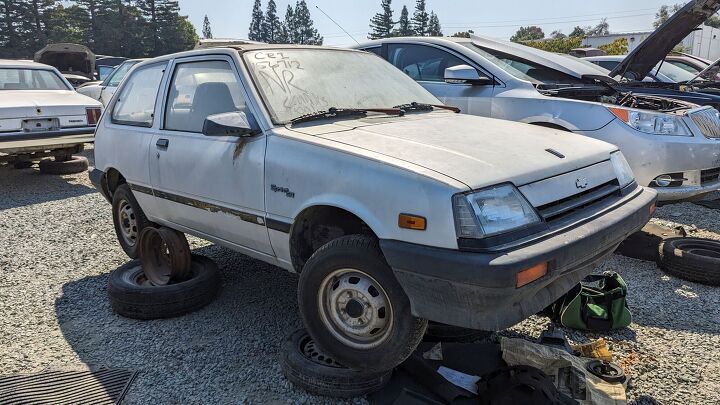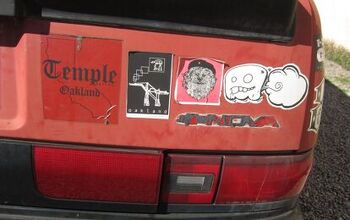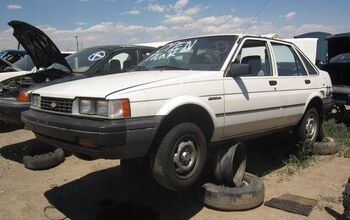Junkyard Find: 1987 Chevrolet Sprint ER

What was the most fuel-efficient (mass-produced, internal combustion-powered, highway-legal, non-gray-market, four-wheeled, et freakin' cetera) new car available in the United States during the 1980s? No, not the Toyota Starlet or Corolla Tercel, not the Honda CRX HF, not the Subaru Justy. It was the Chevrolet Sprint ER, and I've found a nicely intact example in a car graveyard just east of Sacramento.
If you want to be picky, the 1986 Sprint ER was the gas-mileage king of 1980s America, rated at 44 city and 53 highway miles per gallon. The 1987 Sprint ER came in second place, due to its insatiable thirst for go-go juice on the highway (51 miles per gallon).
In order to win the United States MPG crown for the 1985 through 1987 model years (for 1988, the Sprint Metro replaced the Sprint ER), the Sprint ER had a taller final drive gear ratio and a stingier camshaft than the regular Sprint.
It also had an upshift light (located in the lower right corner of the cluster) to remind drivers that fuel economy was more important than brisk acceleration.
Even though memories of the gas lines and fuel rationing of 1979 were still vivid by 1987, oil prices crashed hard during the middle 1980s, hitting bottom in 1986.
The MSRP for the regular '87 Sprint 3-door was $5,995, while the fuel-sipping Sprint ER 3-door listed at $6,110 (that's $16,593 and $16,912 in 2023 dollars). Not many Sprint shoppers were willing to pay the extra 115 smackers to get the ER's 47 combined miles per gallon instead of the base Sprint's 39 combined miles per gallon.
As I was contemplating the first Sprint ER I've seen in at least a couple of decades, the Air Force Thunderbirds screamed overhead as they practiced for the California Capital Airshow.
Less flashy Air Force hardware also roared by, since the junkyards of Rancho Cordova are beneath the flight path to Travis Air Force Base (which was named Fairfield-Suisun Air Force base until a B-29 carrying a "Fat Man" atomic bomb crashed and burned there, killing Brigadier General Robert F. Travis).
The heart of the Sprint was a carbureted 1.0-liter Suzuki three-cylinder engine, rated at 49 horsepower. The next-generation version of this car, the Geo Metro XFi, was the final new production car available in the United States with under 50 horses, using a fuel-injected version of the same Suzuki three-banger.
It appears that this engine was not legal for sale in high-altitude areas.
A five-speed manual was mandatory equipment on the 1987 Sprint ER. Other Sprint models could be purchased with optional automatics that year.
Back in its Japanese homeland, this car was known as the Suzuki Cultus. The second-generation version appeared here in 1989, badged as the Geo Metro. After the Geo brand got the axe in 1997, the Metro became a Chevrolet. Note the black rectangle on the hood; that's the hood release, not a badge.
The Sprint was nowhere near the cheapest new car Americans could buy in 1987. That honor went to the $3,990 Yugo GV, followed by the tied-for-second-place $4,995 Hyundai Excel 3-door hatchback and $4,995 Chevrolet Chevette (yes, new Chevettes were available that late). The Volkswagen Fox, base Subaru 3-door and Plymouth Horizon America undercut the Sprint's price as well.
As even the most miserable econoboxes got heavier and more powerful in later years, the 1986 Sprint ER's fuel-economy numbers seemed untouchable. The original Honda Insight beat it, but it needed a gasoline-electric hybrid powertrain plus a lot of cutting-edge aerodynamic and weight-reduction tricks to pull it off.
The Sprint ER shouldn't be compared to modern hybrids or EVs, though. It achieved its efficiency on straight internal combustion and did it with a carburetor.
Driving a Sprint ER from Los Angeles to New York with three passengers sounds like a nightmare. Just $66 with gas priced at $1.16 per gallon.
Also a better deal than seven horses (the hoofed variety).
Crushes the Hyundai Excel.
It loves to run!
In Canada, this car was badged as the Pontiac Firefly.
The Cultus was available with air conditioning, which would have been nice for those humid Japanese summers.
Versions of this generation of Cultus were sold everywhere, thanks to the long reach of the GM Empire
1987 Chevrolet Sprint ER in California junkyard.
1987 Chevrolet Sprint ER in California junkyard.
1987 Chevrolet Sprint ER in California junkyard.
1987 Chevrolet Sprint ER in California junkyard.
1987 Chevrolet Sprint ER in California junkyard.
1987 Chevrolet Sprint ER in California junkyard.
1987 Chevrolet Sprint ER in California junkyard.
1987 Chevrolet Sprint ER in California junkyard.
[Images: The Author]
Become a TTAC insider. Get the latest news, features, TTAC takes, and everything else that gets to the truth about cars first by subscribing to our newsletter.

Murilee Martin is the pen name of Phil Greden, a writer who has lived in Minnesota, California, Georgia and (now) Colorado. He has toiled at copywriting, technical writing, junkmail writing, fiction writing and now automotive writing. He has owned many terrible vehicles and some good ones. He spends a great deal of time in self-service junkyards. These days, he writes for publications including Autoweek, Autoblog, Hagerty, The Truth About Cars and Capital One.
More by Murilee Martin
Latest Car Reviews
Read moreLatest Product Reviews
Read moreRecent Comments
- Redapple2 jeffbut they dont want to ... their pick up is 4th behind ford/ram, Toyota. GM has the Best engineers in the world. More truck profit than the other 3. Silverado + Sierra+ Tahoe + Yukon sales = 2x ford total @ $15,000 profit per. Tons o $ to invest in the BEST truck. No. They make crap. Garbage. Evil gm Vampire
- Rishabh Ive actually seen the one unit you mentioned, driving around in gurugram once. And thats why i got curious to know more about how many they sold. Seems like i saw the only one!
- Amy I owned this exact car from 16 until 19 (1990 to 1993) I miss this car immensely and am on the search to own it again, although it looks like my search may be in vane. It was affectionatly dubbed, " The Dragon Wagon," and hauled many a teenager around the city of Charlotte, NC. For me, it was dependable and trustworthy. I was able to do much of the maintenance myself until I was struck by lightning and a month later the battery exploded. My parents did have the entire electrical system redone and he was back to new. I hope to find one in the near future and make it my every day driver. I'm a dreamer.
- Jeff Overall I prefer the 59 GM cars to the 58s because of less chrome but I have a new appreciation of the 58 Cadillac Eldorados after reading this series. I use to not like the 58 Eldorados but I now don't mind them. Overall I prefer the 55-57s GMs over most of the 58-60s GMs. For the most part I like the 61 GMs. Chryslers I like the 57 and 58s. Fords I liked the 55 thru 57s but the 58s and 59s not as much with the exception of Mercury which I for the most part like all those. As the 60s progressed the tail fins started to go away and the amount of chrome was reduced. More understated.
- Theflyersfan Nissan could have the best auto lineup of any carmaker (they don't), but until they improve one major issue, the best cars out there won't matter. That is the dealership experience. Year after year in multiple customer service surveys from groups like JD Power and CR, Nissan frequency scrapes the bottom. Personally, I really like the never seen new Z, but after having several truly awful Nissan dealer experiences, my shadow will never darken a Nissan showroom. I'm painting with broad strokes here, but maybe it is so ingrained in their culture to try to take advantage of people who might not be savvy enough in the buying experience that they by default treat everyone like idiots and saps. All of this has to be frustrating to Nissan HQ as they are improving their lineup but their dealers drag them down.























































Comments
Join the conversation
When you think about it it’s amazing how efficient the ICE has become. Back in the day of this Chevy Sprint you could only get such fuel economy by reducing the horsepower, cylinders, engine capacity and stuffing that engine into something small and light.
Today? I mean on Saturday I had to drive to a photo shoot precisely 160 km (100 miles) outside of Munich. I drive a 2018 Mercedes A250 AMG Line (W177) with a turbocharged 2.0 4-cylinder, 224-horsepower, 7-DCT (Double Clutch) and FWD. My car was fully loaded with heavy photographic gear including several heavy batteries for my Elinchrom 1200W portable flashes. The entire trunk and rear seats were filled with my equipment which means WEIGHT.
And yet my average fuel economy for 100 km was 6.6 liters (a solid 35 mpg). Sure, it’s not touching the fuel economy of the Chevy Sprint, but this involved spending almost 30 minutes in Munich traffic before reaching the Autobahn and then cruising at 140 km/h (87.5 mph) with several ventures into the 160-200 km/h zones in a car overloaded with heavy photographic equipment. That’s phenomenal fuel economy. Right now I am drinking water out of a 1.5 liter bottle. They are not very big and when you think about it… my car needed 4.5 bottles (1.5 liters each) to drive 100 km. Insane. As far as I am concerned this whole “But gasoline ICE engines are only 25-35% efficient in thermodynamics!” claim is irrelevant these days. Seriously.
Pic of my ride, her name is… “Priscilla”. 😆
My dad had one of these,tiny tinny little thing that he towed behind a motorhome then drove for years afterwards, from a different era of automobiles, nobody would accept the lack of amenities today